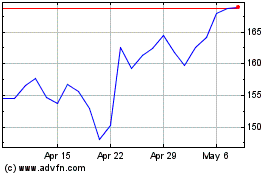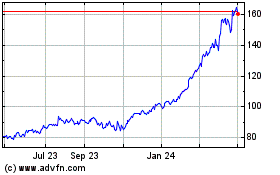In an $11 billion deal, transportation unit to be combined with
transit firm Wabtec
By Thomas Gryta
This article is being republished as part of our daily
reproduction of WSJ.com articles that also appeared in the U.S.
print edition of The Wall Street Journal (May 22, 2018).
General Electric Co. agreed to merge its railroad business with
Wabtec Corp. in a deal valued at roughly $11 billion, letting GE
raise some cash to fund its turnaround and shed one of its oldest
operations.
The transaction is the first major portfolio move in GE Chief
Executive John Flannery's attempt to revamp the struggling
industrial conglomerate. He is in the midst of a strategic review
that could result in other units being separated, in what would
amount to a breakup of the company.
Mr. Flannery, who took over as CEO in August, has promised to
update investors by the end of June with his plans for GE's three
core units: aviation, health care and power. He is also looking for
new ways to shrink its once massive but troubled financial-services
arm.
The 30-year GE veteran has said the company has no "sacred cows"
and is seeking structures that will give each division its best
access to capital to compete, rather than having to fight for
investment within the larger company. The transportation unit,
which mostly manufactures locomotives, is one of the smaller of
GE's seven industrial units.
Wabtec makes equipment for transit systems and freight
railroads. Its CEO, Ray Betler, said in an interview Monday that a
downturn in locomotive demand in recent years highlighted the logic
of the combination. "The stars aligned and it looked like a good
opportunity for us," he said. He added: "The cycle probably helped
to push us together."
GE and Wabtec have talked about a combination on and off for
years, Mr. Betler said, but a deal never came together. Wabtec,
formally known as Westinghouse Air Brake Technologies Corp., has a
market value of about $9 billion, based on Friday's closing stock
price.
GE examined an initial public offering for its transportation
division, which has struggled with falling profit and sales in
recent years. It declined selling to private-equity firms for cash,
people familiar with the matter said, and hopes the Wabtec deal
will allow the business to benefit from expected growth.
GE will receive $2.9 billion in cash at closing. GE shareholders
will own 40.2% of the combined company, with GE owning about 9.9%
after the deal, the companies said Monday. GE is required to sell
its stake in the combined company within three years.
Wabtec shareholders will retain 49.9% of the combined company.
Mr. Betler will serve as CEO after the deal, which is expected to
close in early 2019.
Rather than a straight sale, the deal was structured in a way
that would leave GE shareholders with a stake in a public company
and avoid a big tax bill. It gives GE shareholders a chance to
participate in the turnaround of the struggling transportation
business or cash out if they wish.
Shares in GE rose 1.9% to $15.26 on Monday. The stock has
declined by nearly half over the past year as the company has
lowered financial targets, slashed its dividend and warned it would
take several years to restructure. Wabtec shares gained 3.5% to
$98.55.
The transportation deal might be a sign of things to come for
GE. The company didn't want to simply sell for cash at the bottom
of the business cycle, said a person familiar with the
transaction.
"This is the first step in the continued portfolio pruning, and
GE has a lot of challenging decisions as to how to shape the
portfolio ahead," said Stifel analyst Robert McCarthy.
GE made a similar move last year, when it merged its Oil &
Gas division with Baker Hughes into a new public company. But in
that deal, GE was left with a controlling stake and leadership of
the merged business. With Wabtec, GE itself will own less than
10%.
In October, Mr. Flannery promised to sell $20 billion worth of
assets. Before the Wabtec deal, GE had announced a handful of deals
totaling less than $4 billion. The company's century-old GE
Lighting division has been on the auction block for over a
year.
GE has been looking at options for the transportation division
since at least last fall. The segment mainly produces freight
locomotives, which sell for millions of dollars apiece, along with
mining equipment and marine motors.
Although GE is one of the world's biggest makers of freight
locomotives, a cyclical slump hit the business. In 2017, the unit's
revenue sank 11% and its profit fell 23%. The division accounted
for $4.2 billion of GE's total 2017 revenue of $122.1 billion.
The transportation unit, which was established more than a
century ago, had about 8,000 employees at the start of the year,
down 2,000 from a year earlier, and compared with 313,000 at GE in
total.
GE and Wabtec said they expect the combination to eventually
generate about $250 million in annual savings as well as tax
benefits now valued at roughly $1.1 billion. GE will nominate three
directors to the combined company's board.
Wabtec, which said it will keep its headquarters in Wilmerding,
Pa., had revenue of $3.9 billion last year, or about the same as
GE's transportation division. Wabtec employs about 18,000 people,
or twice as many as GE's transportation division.
GE's diesel locomotives are primarily assembled in Fort Worth,
Texas, and western Pennsylvania.
Mr. Betler said he doesn't expect significant layoffs from the
combination as there are minimal overlaps in the two operations.
Furthermore, he expects coming growth to support the workforce. "If
you are an employee, you want to be part of a stronger company," he
said.
Write to Thomas Gryta at thomas.gryta@wsj.com
(END) Dow Jones Newswires
May 22, 2018 02:47 ET (06:47 GMT)
Copyright (c) 2018 Dow Jones & Company, Inc.
GE Aerospace (NYSE:GE)
Historical Stock Chart
From Mar 2024 to Apr 2024

GE Aerospace (NYSE:GE)
Historical Stock Chart
From Apr 2023 to Apr 2024
